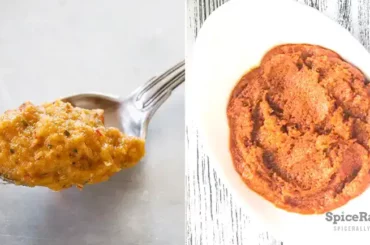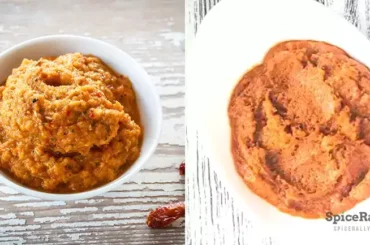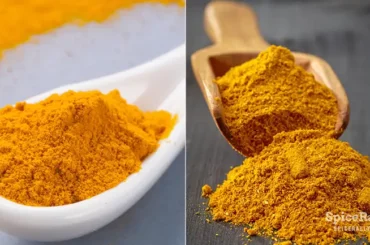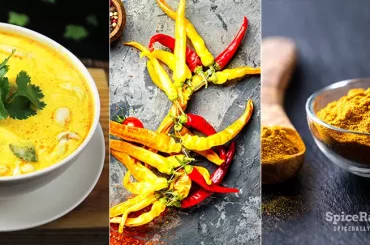Thai curry paste is the key flavoring component of many of their authentic dishes most of the time. On that note, we thought of sharing some important facts about Thai Massaman curry paste Vs Thai Yellow curry paste.
Thai Massaman curry paste and Thai yellow curry paste are two commonly used ingredients in Thai cuisine in association with meat and seafood. Thai Massaman curry paste has a different, spicier, and strong flavor than yellow curry paste. The yellow curry is much milder, yet bolder in flavor. They have their own characteristic usage with several other applications in terms of cooking.
Let’s dive right in and dig in for more information!

Thai Massaman Curry Paste vs Thai Yellow Curry Paste- Spicerally DrillDown
| Thai Massaman Curry Paste | Thai Yellow Curry Paste | |
|---|---|---|
| Base ingredients | A variety of fresh and dried spices | Turmeric with spices/ curry powder |
| Ingredients used | – Cumin – Garlic – Galangal – Thai red chiles – Lemongrass – Coriander root – Coriander seeds – Green cardamom – Cloves – Nutmeg – Cinnamon – Mace – Kaffir lime zest – White pepper – Shrimp paste – Salt Certain variations may also include the following: – Palm sugar – Tamarind paste – Bay leaves – Fish sauce | – Turmeric – Curry powder – Thai yellow/ red chiles in small amounts (dried) – Ground cumin seeds – Garlic – Ground coriander seeds – Galangal – White pepper – Lemongrass – Shrimp paste – Salt – Kaffir lime peel – Shallots Certain variations may also include the following ingredients: – Fenugreek seeds – Cardamom – Mace – Cinnamon – Cloves – Lime juice |
| Flavor profile | Has a more powerful spiced overtone than the yellow curry paste with an earthier element with heaty, smoky, bold flavor details. Gives out the flavor characteristics of Indian curry owing to the bulk of fresh and dried spices. | Thai yellow curry paste is less robust and milder than the Thai Massaman curry paste. Yet, it has a bold “curry” overtone, thanks to the spices and curry powder included. Turmeric adds an earthier element, enhancing the vibrancy of this curry paste. |
| Color | Typically orange-brownish. | Golden yellow in color |
| Texture | Primarily has a coarse, pasty texture. | Typically a smooth paste with less chunks. |
| Heat Level | Hotter than the Thai yellow curry paste | Less hot than the Thai massaman curry paste due to the less number of Thai chiles included. |
| Level of spiciness | Usually spicier than the yellow curry paste | Can be less spicy than the massaman curry paste. But the level of spiciness can be compensated if more spices are added. |
| Main cooking application | Used in Thai Massaman curries | Used in Thai yellow curries |
| Other uses | – In making various savory noodles, rice, and spaghetti dishes – As a base for marinades and wet rubs – Used as a base for stir-fries, soups, and stews – Can be mixed with salad dressings, sauces, dips, and vinaigrettes – Used to enhance the flavor in savory fillings for baked goods and finger foods | – Can be mixed with savory batters – Is an excellent addition with coconut milk-based dishes – Used in stir-fries, to flavor soups and stews – Mixed with savory fillings, noodles and rice dishes – Can enhance the flavor of egg and vegetable dishes |
| Category of culinary ingredient | Cooking ingredient | Cooking ingredient |
| Availability | Can be easily bought from anywhere in Thailand. But, if you’re looking for Thai Massaman curry paste outside of Thailand, you will have to look for it with certain online sellers, Asian stores, or major online shopping sites. | Yellow curry paste is readily available anywhere in Thailand. If you’re trying to purchase this curry from anywhere outside of Thailand, you may look for it in leading supermarkets, online shopping sites, and Asian stores. |
| Storage | – Most shop-bought Thai Massaman curry pastes can be stored outside preferably on the countertop at room temperature. – Homemade recipes will require refrigeration or freezing for a longer shelf life | – Most shop-bought Thai yellow curry pastes can be stored outside preferably on the countertop at room temperature. – Homemade recipes will require refrigeration or freezing for a longer shelf life. |
| Mode of production | Homemade recipes and commercially-made products exist. | Homemade recipes and commercially-made products exist. |
| Variations | No specific variation exists. But the recipe might have slight alterations in ingredients, depending on the production or chef. | No specific variation exists. But the recipe might have slight alterations in ingredients, depending on the production or chef. |
| Origin | South of Thailand | South of Thailand |
More Insights Into The Difference Between Thai Massaman Curry Paste And Thai Yellow Curry Paste
Usage of curry paste in traditional Thai food comes as a long-serving culinary application. They create wonders with different types of curry pastes, each with a different flavor profile that does not second to one another.
Some might fail to understand the difference between these curry pastes and end up confused as not knowing what to use where. That is why you always need an expert opinion to pick the best and the most appropriate for your dishes. As we have explained in the table above, you might see an apparent difference between the ingredients used in each.
Thai Massaman curry is considered in flavor as it contains more spices than in the Thai yellow curry paste. Those spices are mostly associated with Indian and Middle Eastern cooking and most of them are not common to Thai cuisine.
Thus, we can identify Thai Massaman curry paste as a fusion flavoring ingredient. In contrast, Thai yellow curry paste is only capable of lending the most basic Thai flavors with a bold curry element. Another significant difference between these two curry pastes is the addition of turmeric to yellow curry paste. We don’t typically see this ingredient in the Thai Massaman curry paste.
The Difference and Similarities in Cooking
Adding turmeric to the yellow curry paste gives a huge difference in terms of its color and flavor, standing it out from the rest of the basic Thai curry pastes as well as from the Massaman curry paste. Thai Massaman curry paste and Thai yellow curry paste have their own way of adding up to the dishes in terms of cooking.
The Massaman curry paste is specifically used in Thai Massaman curries, while the yellow curry paste is used in various Thai yellow curries. Apart from their major cooking application, their secondary uses do not differ much. However, the massaman curry paste can be used in dishes where you prefer a more strong, more intense, and assertive curry flavor.
At the same time, the yellow curry paste is more suitable for dishes that require a subtle curry hint, with a pleasant color. Nevertheless, the vibrancy of the yellow curry paste should not be underestimated that from the Massaman curry paste.
Talking in terms of substitution, both curry pastes can be best used as alternatives in place of each other as secondary ingredients in certain dishes. But using Thai Massaman curry paste in yellow curries or using the yellow curry paste in Massaman curries is not at all a good idea as it can ruin the authenticity of those dishes.




